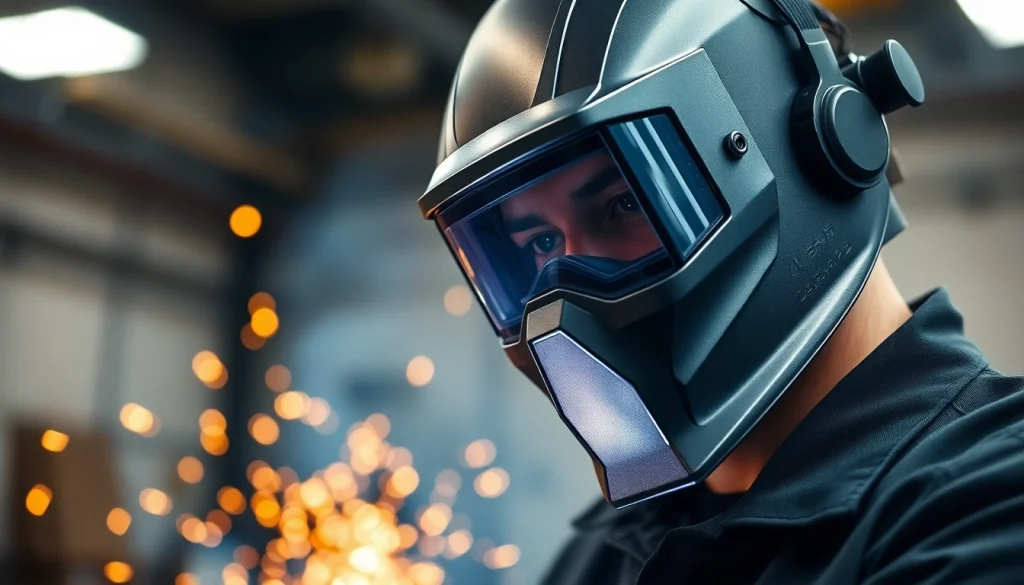Choosing the Right Welding Mask: Types, Features, and Safety Considerations

Understanding Welding Masks
Welding masks are an essential piece of personal protective equipment (PPE) for anyone involved in welding operations. They protect the face, eyes, and neck from the harmful effects of intense light and heat produced during welding. Moreover, with rising concerns about workplace safety, selecting the right welding mask is crucial to maintaining health and ensuring compliance with safety standards.
What is a Welding Mask?
A welding mask, or helmet, is designed to safeguard the welder’s face and eyes from UV and infrared radiation produced by the welding arc, as well as from potential flying sparks and dust particles. Most modern welding helmets feature a protective lens, which may be fixed or auto-darkening, to accommodate various welding processes, including MIG, TIG, and Stick welding.
Main Types of Welding Masks
There are various types of welding masks, each suited for different welding techniques and user preferences:
- Auto-Darkening Welding Masks: These helmets automatically adjust the lens tint to protect the eyes from the bright light generated during welding. They provide convenience and safety since the user doesn’t need to flip the mask up and down.
- Passive Welding Masks: Featuring fixed shade lenses, these masks are simpler and less expensive. However, they require the user to lift the mask up between welds, which can be less convenient.
- Pancake Welding Hoods: Compact and lightweight, these hoods provide a low profile, ideal for tight workspaces. They are typically used for specific applications and may require the use of an auto-darkening filter.
Essential Features of a Quality Welding Mask
When evaluating welding masks, various features play a critical role in their functionality and user comfort:
- Comfort Fit: Adjustable headgear and padding ensure a snug fit, particularly for extended welding sessions.
- Protective Lens Ratings: Quality masks come with different shade ratings suitable for various welding processes. Higher ratings (e.g., 10-12) are typically required for brighter arcs.
- Weight: A lightweight helmet reduces fatigue during prolonged use, making work easier and more comfortable.
- Durability: A helmet made from high-impact resistant materials will withstand harsh working conditions.
Choosing the Right Welding Mask for Your Needs
Selecting the right welding mask requires consideration of multiple factors, including specific welding tasks and comfort preferences. This section will delve into those critical factors.
Factors to Consider When Selecting a Welding Mask
When choosing a welding mask, consider the following factors:
- Type of Welding: Match the mask to the welding process. MIG welding typically requires different lens shading compared to TIG welding due to variance in arc brightness.
- Visibility: Look for helmets with a large viewing area and clear visibility, essential for accuracy and precision during welding.
- Filter Reaction Time: In auto-darkening helmets, check how fast the lenses react to light changes; faster response times minimize eye fatigue.
How to Match Your Weld Type to the Correct Mask
Each type of welding generates differing levels of UV radiation and heat. For instance:
- MIG Welding: Typically requires a shade 10 to 11 lens.
- TIG Welding: May require a lighter shade, around 8 to 10, depending on the amperage.
By understanding the requirements for each welding type, you can select the appropriate helmet with the correct filter and protection level.
Incorporating Comfort and Convenience
Dive deeper into comfort and convenience factors. High-quality welding masks often integrate advanced ergonomic designs with adjustable headbands, allowing for personal adjustments. Additionally, ventilation systems that index airflows prevent fog build-up on lenses, enhancing visibility during the welding process. Consideration of weight is equally vital, as heavier helmets can cause significant neck strain over prolonged periods.
Advanced Features in Modern Welding Masks
Advancements in technology have led to the incorporation of exceptional features in modern welding masks, significantly enhancing user experience and safety.
Auto-Darkening Technology Explained
Auto-darkening technology enables masks to automatically adjust the darkness of the lens suitable to the brightness of the welding arc. This is achieved through a combination of sensors and liquid crystal displays. It allows welders to maintain a clear view of their work area while providing optimal protection during welding tasks. For instance, lenses with a one millisecond reaction time enhance safety for high-speed welding applications by minimizing the risk of eye damage.
Enhanced Protection Ratings
Different welding processes can expose welders to various hazards. Masks that adhere to ANSI Z87.1 standards provide assurance that they meet the necessary safety protocols regarding impact and optical protection. Some masks also feature shade-specific certificates from recognized entities, ensuring they deliver the advertised level of protection.
Visor Designs and Customization Options
Modern welding helmets often feature versatile visor designs. For example, some masks allow for swapping or replacing lenses, thereby enabling customization for varying jobs and user preferences. Furthermore, creative designs such as graphic prints and unique aesthetics allow welders to reflect their style, from intricate designs to minimalist looks.
Maintenance Tips for Welding Masks
Maintaining a welding mask is essential for ensuring the longevity of the equipment and safety during welding tasks. Poorly maintained masks can lead to a reduction in visibility and protective capability.
Cleaning and Care Instructions
Proper cleaning techniques are crucial. Use a soft cloth or lens cleaner specifically designed for welding equipment to clean the lens. Avoid harsh chemicals, as they can damage the anti-fogging coatings or scratch the glass surface. Always remove contaminants like spatter and grime from the outer shell to maintain peak performance.
Storage Best Practices
When not in use, it’s vital to store your welding helmet in a protective case to prevent scratches and damage. Avoid leaving it in areas that are exposed to extreme temperatures or direct sunlight, as this may warp the materials over time.
When to Replace Your Welding Mask
Welding masks are not designed to last indefinitely. Signs that a replacement is necessary include:
- Cracks or deep scratches on the lens that impede visibility.
- Headgear or suspension systems that have lost elasticity and support.
- Any failure in the electronic components of auto-darkening helmets.
Regular inspections can help ensure you are using the current state-of-the-art equipment, optimizing both safety and performance during welding tasks.
Regulatory Standards and Safety Compliance
Understanding the regulatory framework surrounding welding safety is critical for both compliance and operational safety. This section will explore the relevant PPE regulations and their implications for your choice of welding mask.
Understanding PPE Regulations for Welding
The OSHA (Occupational Safety and Health Administration) provides several guidelines regarding the use of personal protective equipment in welding operations. The regulations mandate that all welders must utilize appropriate PPE, including approved helmets that provide adequate protection against hazards like electrical shocks, UV exposure, and heat.
How Standards Affect Your Choice of Welding Mask
When selecting a welding mask, be sure to choose one that meets or exceeds the relevant safety standards for your region. This typically involves looking for PPE that conforms to ANSI, ISO, or local standards regarding impact resistance, electrical safety, and thermal protection.
Impact of Certification on Safety and Performance
Certification ensures that a welding mask has undergone rigorous testing for safety and performance. Investing in a certified mask means you are opting for a product that has demonstrated reliability under expected working conditions. Therefore, it’s essential to look for models with trusted safety certifications to ensure compliance and reliability in your welding tasks.







